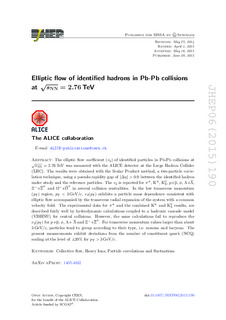Elliptic flow of identified hadrons in Pb-Pb collisions at √sNN = 2.76 TeV
Journal article, Peer reviewed
Permanent lenke
http://hdl.handle.net/11250/2374005Utgivelsesdato
2015Metadata
Vis full innførselSamlinger
- Institutt for mikrosystemer [522]
- Publikasjoner fra CRIStin [3416]
Originalversjon
10.1007/JHEP06(2015)190Sammendrag
The elliptic flow coefficient (v2) of identified particles in Pb-Pb collisions at p sNN = 2.76TeV was measured with the ALICE detector at the Large Hadron Collider (LHC). The results were obtained with the Scalar Product method, a two-particle correlation technique, using a pseudo-rapidity gap of |__| > 0.9 between the identified hadron under study and the reference particles. The v2 is reported for _±, K±, K0 S, p+p, _, _+_, _−+_ + and −+ + in several collision centralities. In the low transverse momentum (pT) region, pT < 3 GeV/c, v2(pT) exhibits a particle mass dependence consistent with elliptic flow accompanied by the transverse radial expansion of the system with a common velocity field. The experimental data for _± and the combined K± and K0 S results, are described fairly well by hydrodynamic calculations coupled to a hadronic cascade model (VISHNU) for central collisions. However, the same calculations fail to reproduce the v2(pT) for p+p, _, _+ _ and _−+_ + . For transverse momentum values larger than about 3 GeV/c, particles tend to group according to their type, i.e. mesons and baryons. The present measurements exhibit deviations from the number of constituent quark (NCQ) scaling at the level of ±20% for pT > 3 GeV/c.
